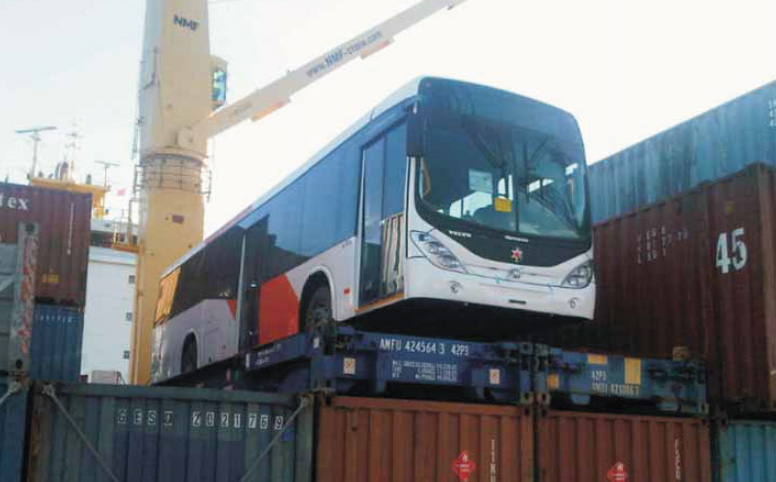
Brazil’s boom has been driving a wave of investment in the construction and farming industries, through to tourism and retail. Tony Danby looks at how economic growth, the upcoming World Cup and expanding agricultural markets are spurring heavy machinery sales and the challenges for logistics.
The Brazilian economy has been revving at a fast pace with companies ramping up production. The government is increasing the country’s highway network, expanding the ports and improving airports. Brazil, which recently overtook Germany as the world’s fourth largest car market, will also host the World Cup in 2014 and the Olympics in 2016, which will require major developments in stadiums and hotels. This all requires hefty investment and large-scale projects. Brazil, Latin America’s largest economy, has navigated through the global financial crisis with apparent ease. Despite a stuttering slowdown in the auto sector in late 2008 and early 2009, the government managed to kick-start vehicle sales with programmes to purchase new cars. It also introduced a host of credit programmes to stimulate private consumers as well as industry and agriculture.
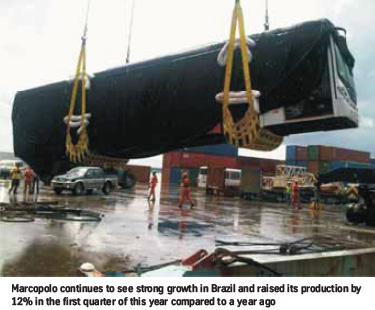 At the same time, the so-called class C, with household incomes of BRL1,100–5,000 ($690–$3,136) a month are clamouring to buy new apartments–often through the social housing programme, Minha Casa Minha Vida–or to shop at new shopping malls that are sprouting up across São Paulo’s suburbs as well as in remote cities in the poorer regions. Others are hopping onto coaches or planes to travel to see the sights, from Rio’s Copacabana beach to the giant Iguaçu waterfalls.
At the same time, the so-called class C, with household incomes of BRL1,100–5,000 ($690–$3,136) a month are clamouring to buy new apartments–often through the social housing programme, Minha Casa Minha Vida–or to shop at new shopping malls that are sprouting up across São Paulo’s suburbs as well as in remote cities in the poorer regions. Others are hopping onto coaches or planes to travel to see the sights, from Rio’s Copacabana beach to the giant Iguaçu waterfalls.
Brazil’s market is now facing economic challenges such as inflation hovering around the government’s upper range target of 6.5% and expected GDP growth at around 4% for 2011 (versus the brisk 7.5% last year). But although the central bank aims to tame potential overheating by applying its brakes on individual and corporate credit, the country’s industry remains confident and prosperous. Local investment and foreign direct investment is pouring into the country.
According to the National Association of Vehicle Manufacturers, or Anfavea, Brazil sold 10,755 buses between January and April, up 22% compared to a year ago, while heavy vehicles sold 16,350 units in the same period, up 13.2% on the year. Semi-heavy vehicles also grew 40% to 18,300 units in the first four months of the year, while the sales of mediumsized vehicles rose 3% to 4,222 units in the same period compared to a year earlier.
Ricardo Alouche, responsible for sales, marketing and aftersales at German manufacturer, MAN, says that this growth  bodes well for the heavy vehicle industry, such as trucks and buses. “This market is being driven mainly by large investments across various sectors such as mining and agriculture, as well as future events such as the World Cup and the Olympics,” he says. The government’s infrastructure programme, PAC, is also a powerful driver for further spending on heavy vehicles, he adds.
bodes well for the heavy vehicle industry, such as trucks and buses. “This market is being driven mainly by large investments across various sectors such as mining and agriculture, as well as future events such as the World Cup and the Olympics,” he says. The government’s infrastructure programme, PAC, is also a powerful driver for further spending on heavy vehicles, he adds.
Nonetheless, Alouche says that the government’s actions mainly aim to improve the infrastructure related to roads such as maintenance and security as well as expanding the bus network. Developing other modalities such as rail and water transport would also be very welcome for more agile, economic and safer transport, he says. MAN uses trucks to transport its heavy vehicles to deliver the vehicles with zero kilometres of mileage on the clock, while only a small part is still transported using their own wheels.
Alouche says that the main challenges to deliver these heavy vehicles to some 145 points of sale (concessionários) is the concentration of demand that occurs in the last days of the month, which is the result of the bulk of sales that occur in this period. For instance, “When we export vehicles or use vessels, the biggest difficulty is the concentration of vehicles to be sent to a single point at the port on a specific date. We, therefore, need to supply the boat at the exact moment that it is moored.”
Transporting new, heavy vehicles to points of sale is done by transport companies deployed by dealerships. The executive explains that MAN’s Latin American operation mainly gives recommendations. “Our function is only to recommend the best alternatives for this type of transport or about insurance,” he says. But according to the executive, MAN’s recent hike in production of heavy vehicles is also subsequently requiring an expansion of the transport companies’ fleets to handle these deliveries.
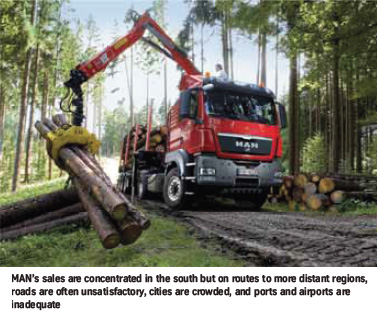 Alouche says that the largest volume of MAN’s sales are concentrated in the south and southeast, which require shorter distances to the dealers. For instance, 51% of MAN’s sales are in a radius of 800km or a single trip of a day. On routes to more distant regions, difficulties arise. Highways or roads are often strewn with potholes, cities are crowded with cars bumper-to-bumper, and ports and airports are inadequate. “The transportation of these heavy finished vehicles is also complicated due to the concentration of sales as well as the long distances,” he says.
Alouche says that the largest volume of MAN’s sales are concentrated in the south and southeast, which require shorter distances to the dealers. For instance, 51% of MAN’s sales are in a radius of 800km or a single trip of a day. On routes to more distant regions, difficulties arise. Highways or roads are often strewn with potholes, cities are crowded with cars bumper-to-bumper, and ports and airports are inadequate. “The transportation of these heavy finished vehicles is also complicated due to the concentration of sales as well as the long distances,” he says.
For the longest routes, such as to the Amazonian city of Manaus (thousands of kilometres from its plant), as well as on the worst highways, other alternative options are sometimes needed. For example, sometimes it is necessary to transport vehicles by river, he says, noting that these factors heighten the risk of damage.
Alouche explains that the attention given to transporting commercial vehicles in comparison to regular cars is similar. The main difference is the volume. While a concessionary receives a truck full of cars, a dealership of lorries will receive just one truck that transports just one heavy vehicle. Getting the logistics to meet its optimal level to transport trucks, because of the low volume, is significant when compared to transporting cars, he says.
Rising fuel prices are another concern. The higher cost of fuel is the main factor that alters the costs of transport, he says, noting it occupies the largest cost.
Marcopolo discovers new territories
The Brazilian busmaker Marcopolo has refocused its strategy of production because of the strong Brazilian real, which has been climbing steadily against the US dollar. Buses exported from Brazil are becoming less competitive, says Nelson Gehrke, Marcopolo’s director of acquisitions and logistics. This has subsequently caused a significant drop in exports. Indeed, for Marcopolo’s buses manufactured in Brazil, only exports to South America remain competitive.
Therefore, in 2005, Rio Grande do Sul state-based Marcopolo switched its strategy and started to work with global sourcing and production in foreign plants to compensate for the high costs in Brazil. Currently, Marcopolo produces almost 40% of its buses outside of Brazil and its suppliers are located in various countries.
Gehrke points out that Marcopolo has also lowered its dependence on Brazilian factories for producing components too. 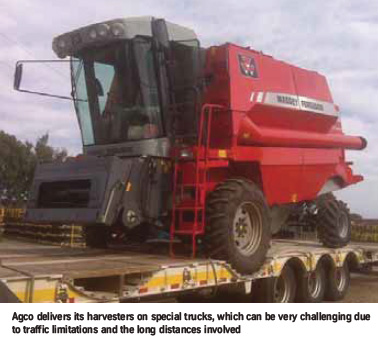 Marcopolo’s factories in locations such as Mexico and India are virtually independent and have their own local suppliers to provide parts.
Marcopolo’s factories in locations such as Mexico and India are virtually independent and have their own local suppliers to provide parts.
Still, Marcopolo continues to see strong growth in Brazil. Marcopolo has hiked its production 12% in the first quarter of this year compared to a year ago. Moreover, the manufacturer expects to produce 18,000 buses and micro-buses this year in Brazil out of a total of 29,500 worldwide. This compared to 27,580 units worldwide of which 18,900 units came from Brazil last year.
In the case of buses, Gehrke says that Marcopolo’s delivery process depends on where the client is located. For Brazilian clients, the vehicles produced in Caxias do Sul or in Rio de Janeiro are driven daily, direct to the garage or location of the client. The same process is used for customers in other parts of South America, he says.
Further afield, for customers in Africa, the Middle East or other regions, the buses are placed on a ship and/or transported by land, and a representative of Marcopolo accompanies the vehicles to the destination. Both for deliveries by drivers as for embarkation on vessels, Marcopolo uses Servicargas Transportes e Serviços in Rio Grande do Sul state. In Gehrke’s opinion, the main challenges are high costs at ports, the difficulties with inadequate port infrastructure, including a lack of investment in dredging that has resulted in blocking some large vessels from entering ports. He also points to the poor state of bus stations, too many highway tolls and red tape, and finally a lack of IT systems at ports, terminals and tax offices.
The main innovation to help the delivery process was to develop and deploy unassembled buses. “Exporting vehicles by SKD [semi-knockdown] or CKD [complete knockdown] systems allows gains in logistics and final assembly is performed at the plants of the company abroad,” says Gehrke.
Agco harvests logistics savings
Brazil’s agricultural market, which is the world’s largest exporter of sugar, coffee and orange juice and the second largest exporter of soybeans, has been buoyed by the government’s programme supporting the sale of low-cost tractors and by funding from the national development bank BNDES. Last year also saw a bumper crop and high prices that helped spur the sale of farm machinery such as four-wheeled tractors and giant combine harvesters.
Henrique Machado, responsible for Agco’s logistics in South America, says that this year the machinery maker expects a slowdown, with an easing of government programmes. Indeed, the first quarter was very slow as the flow of funding eased from the BNDES. The Argentinean government also recently stopped allocating licences to import tractors and combine harvesters from Brazil since February, which also hurts the market, he says. Sales in the tractor and combine harvester market are likely to be lower in Brazil this year than last year, he warns.
Agco transports a wide range of tractors, harvesters, sprayers and additional equipment. It usually loads either six small 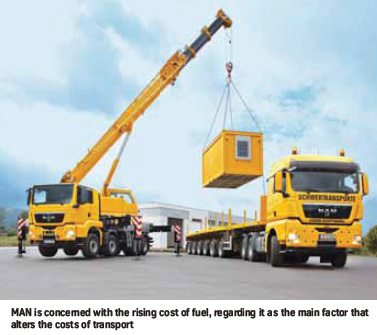 tractors on a standard truck or one harvester on a special truck, which must follow specific traffic rules. The biggest harvester is 3.4 metres high and 3.2 metres wide. “We use slave wheels [narrower wheels] to transport them. Traffic limitations and long distances are some of the challenges involved,” says Machado.
tractors on a standard truck or one harvester on a special truck, which must follow specific traffic rules. The biggest harvester is 3.4 metres high and 3.2 metres wide. “We use slave wheels [narrower wheels] to transport them. Traffic limitations and long distances are some of the challenges involved,” says Machado.
Agco delivers to more than 380 destinations in Brazil for both its Massey Ferguson and Valtra brands. Furthermore, the company transports products to the Argentinean market and many other countries in South America. Agco also exports products worldwide in its own containers or by ro-ro vessels. “We transport our products by road, by truck or by sea on vessels in containers. For the big models [sprayers and harvesters] we need special semi-trailers with minimal distance from the ground. This special equipment allows the big machines to be transported without risk of breaking traffic limitations [height limits].”
Machado says that specialised personnel load the trucks, driving the products onto them. They are tightly strapped to avoid any movement and consequent damage or accident during the trip. Agco currently use the carriers Atrhol and Rodoval to transport its tractors by road for long distances. While it uses Eichenberg, Falcão and Atrhol for export destinations in South America and to ports, for harvesters the company uses the carriers Romeu and Panazzolo, while Atrhol is responsible for the transport of sprayers.
According to Machado, Agco is constantly looking for new opportunities to improve its transport network such as adding new carriers to increase capacity and introduce new technologies. “Our clients want their machines sooner, so we are constantly working to reduce our lead times. The clients’ needs have changed,” he says.
This is also made difficult by the giant size of Brazil. For all of Agco’s plants in Brazil, the manufacturer’s lead times can vary from 2–14 days, depending on the final destination. The continent’s dimensions, which have huge agricultural areas, force the company to travel long distances to reach its customers, some of whom are located in remote areas, he explains. Currently the big challenge is to reduce lead times, even for longer distances, Machado says.
However, some aspects are improving. The risk of theft has reduced dramatically in recent years, while road infrastructure (for some regions) is also much better than it used to be. Indeed, speed must be kept low to avoid damage or accidents, he says. As the number of vehicles on the main roads has increased in recent years, traffic has been a problem as well, Machado adds.
Manufacturers also need to grapple with complex tax rules. For instance, several different taxes (and complex calculations) are applied to transport between states in Brazil. For example, to send a tractor from São Paulo state (where Agco’s Valtra plant is located) to any state in the southern region, a carrier faces 12% for a tax on goods and services called ICMS. If the same tractor goes from São Paulo to the northeast region, ICMS is 7%.
From its Massey Ferguson plant in Rio Grande do Sul state, carriers do not face any ICMS tax. For the products, taxation varies and Agco pays three different rates, from 0–7% depending on the destination, according to Machado.
Constructive logistics
Rogério Nakamura, JCB’s logistics manager in Brazil, says that the market for JCB doubled last year, but it should remain stable in 2011. JCB’s unit in Brazil moves around 3,500 units a year. The World Cup, the Olympics and the needs of infrastructure are the main drivers, he says.
JCB makes heavy vehicles between 1 and 45 tonnes. The majority of machines are backhoe loaders weighing around seven tonnes. The company sells the vehicles as ex-works, which means that all machines are picked up by dealers to deliver across the whole country. Nakamura says that JCB uses WWL for ro-ro shipments, DHL for full container loads and Encaixe Transportes for road transport.
Some routes such as those in the Amazonia region need to process multi-modal transport for 20 days with a risk of robbery, precarious highways and a high risk of damage to the cargo. In general, lorries with trailers are the most used because they are easier to on-load and off-load. Lead times between JCB’s main factory and key destinations include trips of one to three days in the south, about two days in the southeast region, which includes major cities such as Rio de Janeiro and São Paulo, while five days are needed to reach the northeast and 20 days to the remote north of the country, says Nakamura.
Overall, experts are positive about the growth of Brazil’s heavy automotive industry, but they are aware of the expanding needs for improved roads and infrastructure. “We would like the government to improve highways, reduce the tolls, make the roads more secure, reduce the price of fuel, as well as improve the availability of multi-modal transport such as rail and boat to allow forms of transport other than by road,” says Nakamura.
To help improve the situation, Machado would like the government to invest in the expansion and improvement of the country’s road network to guarantee safety and to contribute with lead-time reduction. Ports are also a huge issue, he says. Although the PAC implementation is very important, the programme still faces significant delays. “We really hope government can be faster and deliver what is planned for infrastructure,” he says.


























![Global[1]](https://d3n5uof8vony13.cloudfront.net/Pictures/web/a/d/s/global1_726550.svgz)









